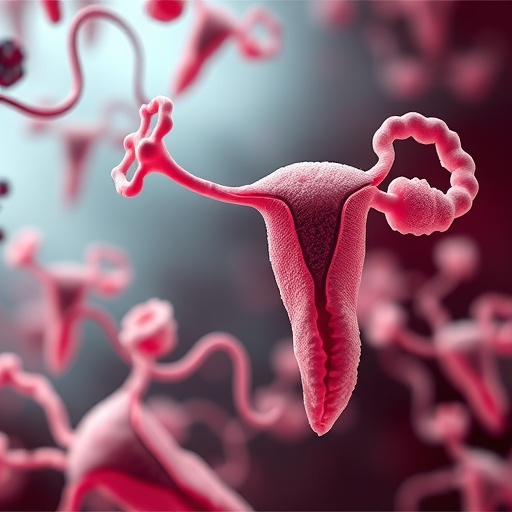In a groundbreaking study that could redefine our understanding of reproductive health, researchers have uncovered intricate interactions between vaginal bacteria and glycans—complex sugar molecules lining the mucosal surfaces of the female reproductive tract. This discovery sheds new light on the molecular dialogues that govern microbiome-host relationships and their profound implications for pregnancy outcomes. As the delicate balance of vaginal microbiota is increasingly recognized for its pivotal role in maintaining reproductive tract health, these findings present a compelling narrative that bridges microbiology, glycobiology, and obstetrics.
The female reproductive tract represents a complex ecological niche where host tissues and microbial communities coexist in a finely tuned equilibrium. Central to this ecosystem are glycans, the sugar-rich molecules that decorate mucosal surfaces and act as biochemical signals, receptors, and barriers. By anchoring and modulating microbial populations, glycans orchestrate interactions that determine microbial colonization patterns and immune modulation. The recent investigation led by Tajadura-Ortega et al. provides the first detailed characterization of how vaginal bacteria bind to these glycans, emphasizing the specificity and variability of these molecular engagements.
Through advanced biochemical assays and high-resolution molecular techniques, the researchers isolated and profiled diverse bacterial species from vaginal samples, mapping their glycan-binding capabilities with unprecedented precision. This methodological approach leveraged glycan arrays that showcase a wide array of glycan structures, enabling precise analysis of bacterial adherence preferences. Importantly, the study revealed that beneficial Lactobacillus species possess unique glycan-binding lectins that allow them to adhere selectively to glycan motifs associated with epithelial defense, thereby maintaining mucosal integrity and preventing pathogenic colonization.
Parallel investigations highlighted that shifts in glycan expression on the vaginal epithelium during hormonal cycles and pregnancy dynamically influence bacterial colonization. The team demonstrated that variations in glycosylation patterns modulate the adhesion profiles of bacteria, potentially underpinning changes in microbiota composition seen in pregnancy complications such as preterm birth or infections. These observations suggest a feedback loop whereby the host’s glycan landscape governs microbial adherence, and microbial activity, in turn, influences glycan expression through inflammatory signaling pathways.
The implications of these findings extend into clinical realms. Vaginal dysbiosis—disruptions in the normal microbial community—is strongly associated with adverse reproductive outcomes including bacterial vaginosis, infertility, and miscarriage. By elucidating the molecular basis of bacteria-glycan interactions, this work paves the way for designing targeted therapies that can restore or maintain healthy microbial populations. For instance, glycoconjugates or synthetic glycan analogs could be devised to enhance beneficial bacterial adherence or block pathogen binding, elevating the precision of probiotic treatments.
Equally striking is the revelation that certain pathogenic bacteria exploit specific glycan motifs to establish infection. The study identified bacterial adhesins that have high affinity for sialylated glycans—structures often upregulated during inflammation or epithelial remodeling. This insight suggests that during episodes of mucosal stress or injury, shifts in glycan expression might inadvertently facilitate pathogen colonization, exacerbating disease progression. Therapeutic strategies that normalize glycan patterns or competitively inhibit these pathogenic adhesins hold promise as novel antimicrobial modalities.
The integration of glycomics and microbiome research embodied in this study underscores the importance of a multidisciplinary approach to reproductive health. The employment of mass spectrometry-based glycan profiling, combined with microbial genomic analyses, allowed for a comprehensive understanding of host-microbe molecular interactions. This systems-level perspective reveals that reproductive tract health and pregnancy outcomes are not merely influenced by bacterial presence but by the molecular crosstalk encoded in glycan recognition and binding.
Furthermore, the researchers noted that the vaginal glycome is highly individualized, influenced by genetic, hormonal, and environmental factors. This variability may explain differences in susceptibility to infections and reproductive complications among women. Personalized medicine approaches that incorporate glycomic profiling could therefore offer tailored strategies to diagnose, prevent, or treat conditions associated with microbiome imbalances.
Significantly, the study extends beyond associations and establishes causal relationships through in vitro and in vivo models. By experimentally manipulating glycan expression on epithelial cells, researchers demonstrated altered bacterial adherence phenotypes and subsequent immune responses. These experiments confirm that glycan structures are active determinants of microbial ecology and immunomodulation within the reproductive tract, rather than passive markers.
This research also opens intriguing avenues for understanding maternal-fetal interactions. The bacterial colonization and glycan expression landscape in pregnancy influence not only maternal health but also fetal development, potentially affecting immune programming and susceptibility to disorders later in life. Understanding how glycans mediate these microbial interactions could reveal mechanisms behind vertical microbial transmission and fetal immune tolerance.
The technological advances fueling this research, including next-generation sequencing, microfluidic glycan arrays, and high-throughput binding assays, demonstrate the power of combining innovative platforms to dissect complex biological systems. As these technologies become more accessible, translating this foundational knowledge into clinical diagnostics and interventions will become increasingly feasible.
Looking forward, the study advocates for expanded research into how external factors such as diet, antibiotics, hormonal contraceptives, and sexual activity influence glycan landscapes and bacterial interactions. Given the dynamic nature of both glycan expression and microbiome composition, longitudinal studies will be essential to unravel temporal patterns and identify critical windows for therapeutic intervention.
In conclusion, the identification and characterization of vaginal bacteria-glycan interactions signify a paradigm shift in reproductive health research. By unveiling the molecular underpinnings of microbiome-host crosstalk, this work offers a blueprint for innovative strategies to promote reproductive tract health, prevent infections, and improve pregnancy outcomes. As the field progresses, integrating glycomic data with microbiome profiling promises to unlock new frontiers in personalized medicine and women’s health.
Subject of Research: Identification and characterization of vaginal bacteria-glycan interactions and their impact on reproductive tract health and pregnancy outcomes.
Article Title: Identification and characterisation of vaginal bacteria-glycan interactions implicated in reproductive tract health and pregnancy outcomes.
Article References:
Tajadura-Ortega, V., Chai, W., Roberts, L.A. et al. Identification and characterisation of vaginal bacteria-glycan interactions implicated in reproductive tract health and pregnancy outcomes.
Nat Commun 16, 5207 (2025). https://doi.org/10.1038/s41467-025-60404-1
Image Credits: AI Generated




